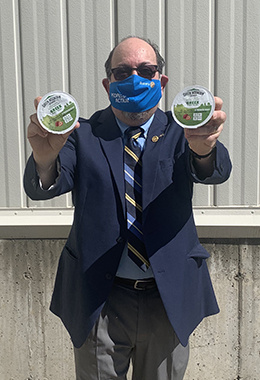
Martin Cohn holds up containers of Green Mountain Yogurt made from surplus milk.
By Martin Cohn, past president of the Rotary Club of Brattleboro, Vermont, USA
In the early days of the COVID-19 pandemic, Vermont dairy farmers were in trouble. With the close of colleges and restaurants, there was too much supply of milk. This excess was headed to be spilled into mudholes. At the same time, the need to help food-insecure families was increasing. How could food that was being wasted reach people who needed food?
That’s when I heard about a project where the Vermont Agency of Agriculture, Food and Markets was coordinating an effort to recover raw milk from being disposed of while creating a new, temporary food supply for Vermont Foodbank. In collaboration with the Vermont Community Foundation, $60,000 was made available to purchase this milk for the benefit of Vermonters. These efforts were particularly important as Vermont’s dairy industry, like all sectors, had been challenged by COVID-19 but remain essential to the state’s food supply. However, more money was needed.
When I heard about the need, I sprang into action. I sent out emails to fellow Rotarians and within days an additional $10,500 was raised. These monies came from eight Rotary clubs, a donation from the District 7870’s Youth Exchange, and the District 7850 Foundation. This helped cover the cost of 32,000 gallons of milk, ingredients, and processing to create 48,000 cups of Green Mountain Yogurt, 11,500 gallons of Hood Dairy 2% Milk, and 440 pounds of Ploughgate Creamery butter.
Secretary Anson Tebbetts of the Vermont Agency of Agriculture said, “This is what Vermont is all about. Neighbors helping neighbors. Thank you Rotarians, farmers, and businesses. You and so many are helping those in need.” Media reports identified Rotary as being a good collaborator in finding a solution.
But there is more to the story. The state of New Hampshire had similar issues. The difference this time was that the cost of milk had gone up; making the filling of tankers too expensive. The solution was to have the New Hampshire Foodbank buy dairy products directly from dairy farmers. Calls were made to the NH Agency of Agriculture, the Granite State Dairy Promotion Board, the NH Foodbank, and the NH Charitable Trust. Again, emails and presentations to Rotary clubs resulted in nearly $18,000, coupled with monies from NH Charitable Foundation, enough money to set the project in motion.
This is another example of Rotary in Action. I am proud to be part of an organization of committed community problem solvers. This project was a success and one that could be replicated anywhere that you can ask, “Got Milk?”
As I have been presenting this project to Rotary clubs in Vermont and New Hampshire, I was reminded of the time my mother would give me a quarter every Friday to give to my teacher to buy containers of milk for the following week in school. If every Rotarian donated one dollar each week and then gave all the money to their local food bank or pantry, more milk could be purchased for food-insecure folks while helping local dairies. Perhaps this is a project for another day.
https://blog.rotary.org/2020/09/03/no-use-crying-over-spilled-milk/
